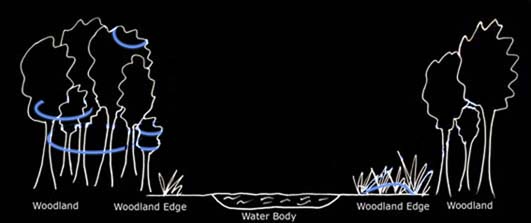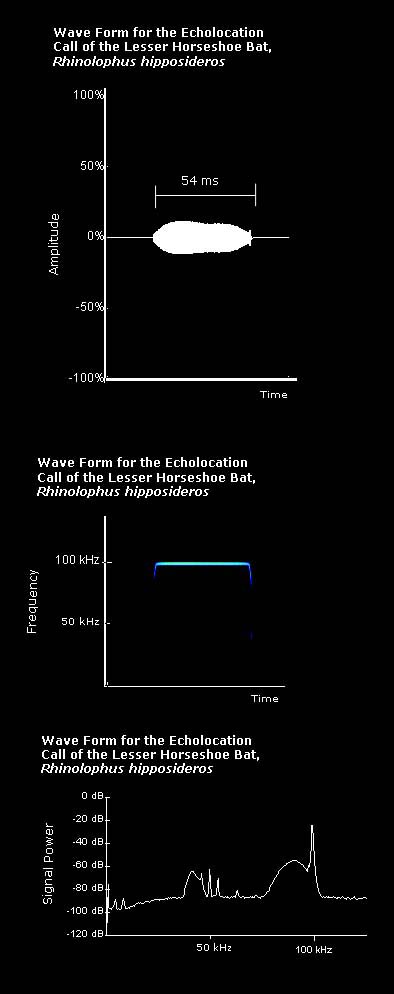

|
||
|
Morphological Description
The diagram below gives important average body measurements for lesser horseshoe bats (Greenaway & Hutson, 1990). |
||
|
||
|
||
|
 |
|
| The British and World distributions are shown by the white areas of the maps above (as given by Richardson, 2000 and Corbet & Harris, 1991 respectively). | ||
|
• Rare, localised populations occur in south west England, Wales and western Ireland. |
||
|
||
|
• Sheltered valleys, woodland edge, pasture and wetlands. • Loss of foraging habitat may be responsible for the decline in lesser horseshoe bat populations in Europe. A study on lesser horseshoe bats in Monmouthshire, UK, showed that they mainly foraged in broadleaf woodlands, as well as in other woodlands and areas of high habitat diversity (Bontadina et al., 2002). As a result of these findings, Bontadina et al. emphasise the importance of conserving such habitats if they occur within 2.5km of a lesser horseshoe bat nursery roost. Motte and Libois (2002) found similar results from a study in Belgium and recommend the conservation of woodlands and hedgerows within 1-2km of lesser horseshoe bat roosts. • The photograph on the left shows a typical habitat of lesser horseshoe bats.
|
||
|
||
|
||
• Forages close to dense vegetation in pasture, woodland and water environments. • Often uses temporary night feeding perches to eat larger prey. • The diet of lesser horseshoe bats mainly consists of Diptera, particularly the suborder Nematocera. Nematocerans are generally crepuscular and the males often swarm (Vaughan, 1997). Lesser horseshoe bats forage using hawking and gleaning strategies. Perch-hunting may also be used. |
||
 |
||
|
Marked in blue on the diagram above is a typical foraging path of lesser horseshoe bats (based on Russ, 1999). |
||
|
||
 |
The echolocation call of lesser horseshoe bats is constant frequency with a frequency modulated component at the start and end. | |
|
To listen to the call of the lesser horseshoe bat click here Size of sound file: 86.5 KB |
||
| For details of how the echolocation calls were recorded click here. | ||
|
Average values for a lesser horseshoe bat echolocation call, as given by Vaughan et al. (1997), are listed below: Interpulse interval: 79.9ms Call duration: 40.3ms Minimum frequency: 98.6kHz The power spectrum on the left shows that the maximum power of the call is at a frequency of approximately 100 kHz. Lesser horseshoe bats have a constant-frequency (CF) component to their calls. Male bats have a lower frequency CF component than females. Bats less than a year old have a lower frequency CF component than older bats (Jones et al., 1992).
|
||
|
|
||
|
• The British pre-breeding population was estimated at 14,000 in 1995 (7000 in England, 7000 in Wales ) (Harris et al., 1995). • Lesser horseshoe bats have become extinct in the last 50 years in the north midlands and northern England (Schober & Grimmberger, 1989) . • The worldwide IUCN status (2001) for lesser horseshoe bats is Vulnerable. • Recent data indicate that the lesser horseshoe population may be increasing (Bat Conservation Trust 2001; Warren & Witter 2002). • Summer and winter roost sites need to be protected. Potential roost entrances should be left unobstructed. • Warren and Witter (2002) found that lesser horseshoe bat populations in Wales appeared to be stable from 1993-1997. They estimated the total Welsh population to be in excess of 10,000 individuals. Lesser horseshoe bat roost sites in Britain are currently conserved as part of conservation management schemes. The results of this study show that current conservation measures are adequate to maintain lesser horseshoe bat populations in Wales . Warren and Witter (2002) suggest that the number of lesser horseshoe bats in Wales might be increased by protecting potential roost sites, such as old buildings, and protecting and improving hibernacula and foraging habitats.
|
||
 © School of Biological Sciences, University of Bristol 2005. Last modified 24th February 2005. © School of Biological Sciences, University of Bristol 2005. Last modified 24th February 2005. |
||